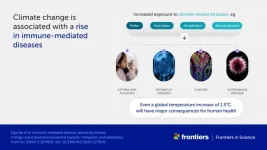(Press-News.org) An extensive CO2 monitoring network set up around the San Francisco Bay Area by an atmospheric chemist from the University of California, Berkeley, has recorded the first evidence that the adoption of electric vehicles is measurably lowering the area's carbon emissions.
The network of sensors, most of them in the East Bay, is the brainchild of Ronald Cohen, UC Berkeley professor of chemistry, who envisions inexpensive, publicly funded pollution and carbon dioxide monitors widely distributed around urban areas to pinpoint emission sources and the neighborhoods most affected. An estimated 70% of global CO2 emissions come from cities, yet few urban areas have granular data about where those emissions originate.
In 2012, Cohen began setting up a Bay Area sensing network that has now grown to more than 80 stations, including seven in San Francisco, that stretches from Sonoma County through Vallejo and down to San Leandro.
Between 2018 and 2022, 57 of the sensors in the Berkeley Environmental Air Quality and CO2 Network (BEACO2N) recorded a small but steady decrease in CO2 emissions — about 1.8% annually — that translates to a 2.6% yearly drop in vehicle emission rates. Looking at California data for electric vehicle adoption — which is very high in the Bay Area — Cohen and graduate student Naomi Asimow concluded that the decrease was due to passenger vehicle electrification.
"That's 2.6% less CO2 per mile driven each year," said Asimow, who is in the Department of Earth and Planetary Science.
The study, Cohen said, shows the utility of an urban network for monitoring and managing federal, state and city mandates for CO2 reduction.
"We show from atmospheric measurements that adoption of electric vehicles is working, that it's having the intended effect on CO2 emissions," Cohen said.
This good news is tempered by the fact that, to meet California and Bay Area carbon reduction goals, the yearly decrease needs to be much greater.
"The state of California has set this goal for net zero emissions by 2045, and the goal is for 85% of the reduction to come from actual reduction of emissions, as opposed to direct removal of CO2 from the atmosphere. What we report is around half as fast as we need to go to get to net zero emissions by 2045," Asimow said.
"We're at 1.8% per year today. To get to the state's goal, we would need 3.7%," Cohen added. "So it's not crazy higher than where we are; we're almost half of the way to that goal. But we have to sustain that for another 20 years."
The results emphasize the urgent need for accelerated actions to reduce CO2 in order to achieve the ambitious zero emission targets that cities seek, he said.
Asimow, Cohen and their colleagues will publish their findings online April 4 in the journal Environmental Science & Technology.
How to monitor climate goals
One impetus for the study was to see whether the BEACO2N network could detect any downward trend in vehicle emissions since the state set goals for greenhouse gas reduction and the electric vehicle market has blossomed.
"We were curious if our data would show us our progress toward meeting California's emissions goals," Asimow said.
Typically, CO2 emissions are estimated from known sources of carbon: how much gas is used in heating and, for vehicles, the fuel efficiency of registered vehicles in an area and overall fuel consumption. Asimow and Cohen noted that this "bottom-up" method for estimating carbon dioxide emissions did not predict the small but significant downward trend in CO2 emissions.
The UC Berkeley team's estimates combined direct CO2 measurements with meteorological data to calculate ground-level emissions — an approach using atmospheric observations that did pick up the modest downturn in CO2 levels. The researchers employed a Bayesian statistical analysis that started with estimates based on economic data, but they revised them based on their network's measured CO2 concentrations and a meteorological model to predict where the emissions originated.
Cohen argues that his sensors are inexpensive enough — less than $10,000 per sensor, versus 20 times as much for pollution monitoring stations operated by the Environmental Protection Agency — that major cities could afford to install a network to get a more granular view of unhealthy areas and sources of pollution. The network sensors also measure five critical air pollutants: carbon monoxide, nitrous oxides (NO and NO2), ozone and particulates (PM 2.5).
Los Angeles, California; Providence, Rhode Island; and Glasgow, Scotland, have already adopted Cohen's sensors to create their own pollution monitoring networks.
"We show that you can make observations and measure changes due to policies of all kinds in a cost-effective and relatively rapid way," Cohen said. "The network involves about half a million dollars' worth of equipment — a one-time investment — and a person per year thinking about it. One of our goals is to demonstrate, both on the CO2 and the air quality side of what we do, that this is cost-effective and translatable and easily accessible to the public in a way that nothing else is."
In the future, satellites could monitor carbon dioxide levels across wide areas and with more granularity, but those satellites are not yet available, Cohen said.
"The optimal solution will be some combination of space-based assets and ground-based measurements," he said.
Asimow was supported by a National Science Foundation Graduate Research Fellowship (1752814). Former Miller Postdoctoral Fellow Alexander Turner, now at the University of Washington in Seattle, also contributed to the research.
END
Electric vehicles are lowering Bay Area's carbon footprint
Monitors throughout the region record small decrease in CO2 emissions over 5 years
2024-04-04
ELSE PRESS RELEASES FROM THIS DATE:
SynGAP Research Fund (SRF) awards collaborative grant to advance research of SYNGAP1 related disorders in adults
2024-04-04
Toronto, CANADA & Rotterdam NETHERLANDS – March 2024 – The SynGAP Research Fund 501(c)(3) today announced a grant to Dr. Danielle Andrade, Dr. Miles Thompson, Dr. Ryan Yuen, Dr. Rogier Kerssebook, and Dr. Anatoljevna Anna Kattentidt to support research on SynGAP-Related Disorder (SRD) in adults. SRD is a rare neurodevelopmental disorder that causes severe intractable epilepsy, and intellectual disability, and is one of the leading genetic causes of autism (1,2).
Dr. Andrade’s team recently published the only research on SRD in adults ...
With the planet facing a 'polycrisis', biodiversity researchers uncover major knowledge gaps
2024-04-04
A scientific review has found almost no research studying the interconnections across three major threats to planetary health, despite UN assessments suggesting one million species are at risk of extinction, a global pandemic that resulted in over six million excess deaths, and a record-breaking year of global temperatures.
“When we began to look into it, we had suspicions the number of studies would be low, but not that low,” says Dr. Jonathan Davies, a researcher with University of ...
Liberalization of medical marijuana and mental health in the USA
2024-04-04
The approval of marijuana for medical use has had little effect on the mental health of the general population in the US. But legalization for therapeutic purposes does benefit those for whom it is intended. This is the conclusion of a study by researchers at the University of Basel.
In the US, access to marijuana has been facilitated in most states since the mid-1990s – whether through medical clearance or through decriminalization of recreational use. However, liberalization is still controversial, and the effects on the well-being of specific groups and the therapeutic value ...
Scientists call for urgent action to prevent immune-mediated illnesses caused by climate change and biodiversity loss
2024-04-04
The ecosystems we live in don’t work the way they used to — and that’s bad for our health. Climate change, pollution, and falling biodiversity are all damaging our immune systems. The lack of positive environmental exposures to build the strength of our immune systems, and the increasing negative exposures which attack those systems, are combining to cause a dramatic rise in immune-mediated diseases like asthma and cancer. Measures to protect against this could have a very powerful return on investment: an estimated $1 spent on climate change mitigation saves $3 on healthcare costs. A global ...
Scientists identify rare gene variants which confer up to 6-fold increase in risk of obesity
2024-04-04
A study led by Medical Research Council (MRC) researchers has identified genetic variants in two genes that have some of the largest impacts on obesity risk discovered to date.
The discovery of rare variants in the genes BSN and APBA1 are some of the first obesity-related genes identified for which the increased risk of obesity is not observed until adulthood.
The study, published in Nature Genetics, was led by researchers at the MRC Epidemiology Unit and the MRC Metabolic Diseases Unit at the Institute of Metabolic Science, both based at the University ...
Adult fish struggle to bounce back in marine protected areas
2024-04-04
Age matters when determining how to protect life in the ocean; every population needs a strong cohort of adults to produce the next generation. But many marine protected areas (MPAs) are falling short of their most basic purpose: to rebuild struggling fish populations. In a new study published April 4 in Global Change Biology, scientists looked at the age breakdown of reef fish in marine protected areas for the first time. They discovered in almost all of them, adult fish populations have either flatlined or declined.
“Adult fish are really important,” said ...
Mayo Clinic study finds active workstations may improve cognitive performance
2024-04-04
ROCHESTER, Minn. — A recent Mayo Clinic study suggests that active workstations incorporating a walking pad, bike, stepper and/or standing desk are successful strategies for reducing sedentary time and improving mental cognition at work without reducing job performance. Extended sedentary behavior, whether at work or home, increases a person's risk of preventable chronic diseases.
"Our findings suggest that it is feasible to blend movement with office work that previously would have been done during long periods of sitting. Active workstations may ...
Tracing the largest solar storm in modern times from tree rings in Lapland
2024-04-04
A research group coordinated by the University of Helsinki was able to measure a spike in radiocarbon concentration of trees in Lapland that occurred after the Carrington flare. This discovery helps to prepare for dangerous solar storms.
The Carrington Event of 1859 is one of the largest recorded solar storms in the last two centuries. It was seen as white light flares on a giant sunspot group, fires at telegraph stations and disturbances in geomagnetic measurements, as well as aurorae even in tropical regions.
In a joint study carried ...
Shy sea anemones are more likely to survive heatwaves
2024-04-04
Even in nature, pride can prevail. A study with researchers from the University of Gothenburg shows that sea anemones that react more slowly to change can survive a heatwave better than individuals that change their behaviour quickly.
Along the Atlantic coasts of Europe, many species are exposed to abrupt shifts in habitat. Tides, storms and rapid temperature changes are commonplace for the marine species that live there. With climate change, heatwaves are expected to become more frequent, and researchers wanted to find out how coastal marine species cope with extreme water temperatures. They chose to study the sea anemone species Actinia ...
Researchers at UMass Amherst are listening in on the world’s rulers—insects—to better gauge environmental health
2024-04-04
AMHERST, Mass. – Recent research led by the University of Massachusetts Amherst evaluates how well machine learning can identify different insect species by their sound, from malaria-carrying mosquitoes and grain-hungry weevils to crop-pollinating bees and sap-sucking cicadas. Listening in on the insect world gives us a way to monitor how populations of insects are shifting, and so can tell us about the overall health of the environment. The study, published in the Journal of Applied Ecology, suggests that machine and deep learning are becoming the gold standards for automated ...
LAST 30 PRESS RELEASES:
Strategic river sensors could have forewarned of Texas Camp flood disaster
Drone sampling of whale breath reveals first evidence of potentially deadly virus in Arctic
Roman soldiers defending Hadrian’s Wall infected by parasites, study finds
Pinochet’s prisoners were tormented with music but still found solace in it, a new book reveals
Fertility remains high in rural Tanzania despite access to family planning
AI-assisted device can improve autism care access
Kinetic careers
Uncovering how parasitic plants avoid attacking themselves to improve crop resistance
Nanoparticle vaccine strategy could protect against Ebola and other deadly filoviruses
Study finds brain care score can predict risk of stroke across racial groups
Key lung immune cells can intensify allergic reactions
Do hormones explain why women experience more gut pain?
New materials conduct ions in solids as easily as in liquids
Breakthrough of the Year: Renewable energy begins to eclipse fossil fuel-based sources
LLM use is reshaping scientific enterprise by increasing output, reducing quality and more
Introducing LightGen, a chip for ultra-fast, ultra-efficient generative AI
Astronomers see fireworks from violent collisions around nearby star
ACC/AHA issue new guideline on managing congenital heart disease in adults
Cosmic crash caught on camera
Is talented youth nurtured the wrong way? New study shows: top performers develop differently than assumed
Ants: An untapped resource in the development of antibiotics?
Archaeologists use AI to create prehistoric video game
Mitochondria migrate toward the cell membrane in response to high glucose levels
Tiny viral switch offers hope against drug-resistant bacteria
Most parents aware of early peanut introduction guidelines, but confused about details
HPV vaccine can protect against severe lesions of the vulva and vagina
Virtual care provision and emergency department use among children and youth
Quadrivalent HPV vaccine and high-grade vulvovaginal lesions
Insights into dry eyes gained from stem cell-derived tear glands
Researchers identify 166 human pluripotent stem cell lines available for use in clinical applications
[Press-News.org] Electric vehicles are lowering Bay Area's carbon footprintMonitors throughout the region record small decrease in CO2 emissions over 5 years






